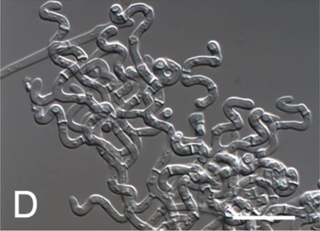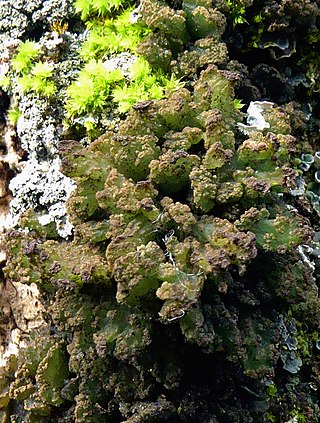
Eurotiomycetes is a large class of ascomycetes with cleistothecial ascocarps within the subphylum Pezizomycotina, currently containing around 3810 species according to the Catalogue of Life. It is the third largest lichenized class, with more than 1200 lichen species that are mostly bitunicate in the formation of asci. It contains most of the fungi previously known morphologically as "Plectomycetes".

Sordariomycetes is a class of fungi in the subdivision Pezizomycotina (Ascomycota). It is the second-largest class of Ascomycota, with a worldwide distribution that mostly accommodates terrestrial based taxa, although several can also be found in aquatic habitats. Some are phytopathogens that can cause leaf, stem, and root diseases in a wide variety of hosts, while other genera can cause diseases in arthropods and mammals.
The Adelococcaceae are a family of fungi in the order Verrucariales. Species are mostly found in north temperate regions, and are biotrophic or necrotrophic on lichens. The family was proposed by mycologist Dagmar Triebel in 1993.

Physconia is a genus of lichen-forming fungi in the family Physciaceae. It has about 25 species. The genus was circumscribed by Czech lichenologist Josef Poelt in 1965, with Physconia pulverulenta assigned as the type species.
Phaeochorella is a genus of fungi It was formerly placed in the family Phyllachoraceae, before in 2020 placed in the monotypic family of Phaeochorellaceae.

Heteroplacidium is a genus of lichen-forming fungi in the family Verrucariaceae. The genus was circumscribed by Austrian lichenologist Othmar Breuss in 1996 with Heteroplacidium imbricatum assigned as the type species. It was proposed as a segregate of Catapyrenium. Other morphologically similar genera are Neocatapyrenium, Placidium, and Scleropyrenium, although molecular phylogenetic analyses indicate that they are independent monophyletic lineages within the Verrucariaceae.
Allophoron is a genus of fungi in the division Ascomycota. The relationship of this taxon to other taxa within the division is unknown, and it has not yet been placed with certainty into any class, order, or family. This is a monotypic genus, containing the single lichen species Allophoron farinosum, found in Colombia. The genus and species were described as new in 1942 by Czech lichenologist Josef Nádvorník.
Antimanoa is a fungal genus in the division Ascomycota. The relationship of this taxon to other taxa within the division is unknown, and it has not yet been placed with certainty into any class, order, or family. This is a monotypic genus, containing the single species Antimanoa grisleae, originally collected from Venezuela. The genus and species were described as new to science in 1930 by German mycologist Hans Sydow.

The Annulatascaceae are a family of fungi in the monotypic order Annulatascales of the class Sordariomycetes of the Ascomycota. The family had not been assigned to any order, until 2020 when it was placed with a new order Annulatascales M.J. D'souza, Maharachch. & K.D. Hyde.
Cyanoannulus is a fungal genus in the family Annulatascaceae of the Ascomycota. This is in the monotypic order of Annulatascales of the class Sordariomycetes. It was formerly classed as Sordariomycetes class in 2007.
Jugulospora is a genus of fungi that was placed within the Lasiosphaeriaceae family, It was then moved into the Neoschizotheciaceae family. This was thought to be a monotypic genus, containing the single species Jugulospora rotula, until more species were found.

Arachnomyces is a genus of cleistothecial ascomycete fungi described in 1902, of which the anamorph (asexual) stage is the genus Onychocola. Although morphologically similar to members of other families, the fungus now belongs to its own monotypic family Arachnomycetaceae, which is the only family in the monotypic order Arachnomycetales.

The Arctomiaceae are a family of lichenized fungi in the Ascomycota, class Baeomycetales. The family was named by Theodor Magnus Fries in 1861, with Arctomia as the type genus. Species in this family are found in arctic and subarctic habitats, usually associated with bryophytes.
The Ceratostomataceae are a family of fungi in the phylum Ascomycota, class Sordariomycetes, subclass Hypocreomycetidae and order Coronophorales.
The Vialaeaceae are a family of fungi in the Ascomycota and class Sordariomycetes. In 2018, it was placed in the order Amphisphaeriales.
Antennulariella is a genus of fungi in the family Antennulariellaceae. The genus was circumscribed in 1915 by Russian mycologist Nikolai Nikolaevich Woronichin, with Antennulariella fuliginosa assigned as the type species.

The Capnodiaceae are a family of fungi in the Ascomycota, class Dothideomycetes. Species in the family have a widespread distribution, and are especially prevalent in tropical and subtropical areas, as well as temperate rainforests.
The Piedraiaceae is a monotypic family of fungi in the Ascomycota, class Dothideomycetes, within the Capnodiales order.
Tania is a genus of lichenized fungi in the family Roccellaceae. It has two species. The genus was circumscribed by Maria Egea Fernández, Pilar Torrente and Harrie Sipman in 1995, with Tania lanosa assigned as the type, and at that time, only species. A second species, T. mohamedii, was added to the genus in 2006. The genus name honours bryologist Benito Ching Tan (1946–2016), who organized the expedition to Mount Kinabalu and collected the type species with Sipman.

The Nitschkiaceae are a family of fungi in the Ascomycota, order Coronophorales. Species in the family are mostly saprobic on wood, although some grow on lichens.








